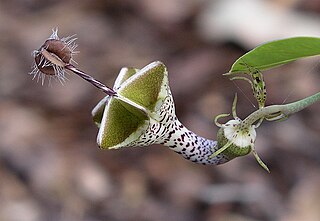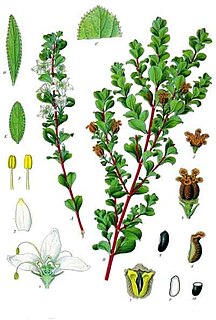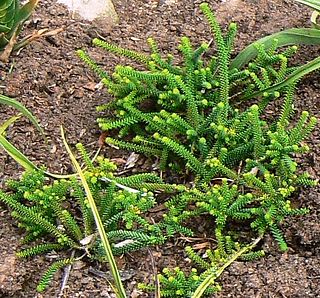
Ceropegia is a genus of plants within the family Apocynaceae, native to Africa, southern Asia, and Australia. It was named by Carl Linnaeus, who first described this genus in his Genera plantarum, which appeared in 1737. Linnaeus referred to the description and picture of a plant in the Horti Malabarici as the plant for which the genus was created. In 1753 he named this species as Ceropegia candelabrum. Linnaeus did not explain the etymology but later explanations stated that the name Ceropegia was from the Greek word keropegion κηροπηγɩον. This means candelabrum in Latin, which has a broader range than the modern word - "a candlestick, a branched candlestick, a chandelier, candelabrum, or also lamp-stand, light-stand, sometimes of exquisite workmanship".

In biology, a rachis is a main axis or "shaft".

Agathosma is a genus of about 140 species of flowering plants in the family Rutaceae, native to the southern part of Africa. Common names include Buchu, Boegoe, Bucco, Bookoo and Diosma. Buchu formally denotes two herbal species, prized for their fragrance and medicinal use despite their toxicity. In colloquial use however, the term is applied to a wider set of fragrant shrubs or substitutes.

Banksia elegans, commonly known as the elegant banksia, is a species of woody shrub that is endemic to a relatively small area of Western Australia. Reaching 4 m (13 ft) high, it is a suckering shrub that rarely reproduces by seed. The round to oval yellow flower spikes appear in spring and summer. Swiss botanist Carl Meissner described Banksia elegans in 1856. It is most closely related to the three species in the subgenus Isostylis.

Agathosma betulina is a flowering plant in the family Rutaceae, native to the lower elevation mountains of western South Africa, where it occurs near streams in fynbos habitats.

Agathosma crenulata is a flowering plant in the family Rutaceae, native to the lower elevation mountains of southwestern South Africa, where it occurs near streams in fynbos habitats. It is an evergreen shrub growing to 1.5-2.5 m tall. The leaves are opposite, oval, 15–35 mm long and 7–18 mm broad. The flowers are white or pale pink, with five petals; the fruit is a five-parted capsule which splits open to release the seeds.

Agathosma serratifolia, known as longleaf buchu or long buchu, is an erect, South African shrub, belonging to the citrus family Rutaceae. It is one of about 135 species mainly occurring in the south-western Cape Province. There, it is found on mountain slopes, wooded ravines, and valleys. The leaves are simple, ovoid, slightly serrated, and 0.5-3.5cm long. In April and May, the plant produces 5-petalled flowers. 'Agathosma' = 'good smell', 'serratifolia' = 'serrate leaved'.

Chamaedorea elegans, the neanthe bella palm or parlour palm, is a species of small palm tree native to the rainforests in Southern Mexico and Guatemala. The parlor palm is one of the most heavily sold houseplant palms in the world. It is one of several species with leaves that are harvested as xate.

Kerriodoxa elegans, the white backed palm, is the only species of palm tree in the genus Kerriodoxa, in the family Arecaceae.

Agathosma gonaquensis is a species of plant in the family Rutaceae. Its habitat is restricted to a tiny area of the Eastern Cape, South Africa. According to the South African National Biodiversity Institute, it is critically endangered.
Ctenium elegans is an annual grass species in the genus Ctenium from African savanna areas. It is distributed from Senegal to the Sudan and grows on sandy soils of the South Sahelian and North Sudanian zones.

Zinnia elegans known as youth-and-age, common zinnia or elegant zinnia, is an annual flowering plant in the daisy family Asteraceae. It is native to Mexico but grown as an ornamental in many places and naturalised in several places, including scattered locations in South and Central America, the West Indies, the United States, Australia, and Italy.

Buddleja agathosma is endemic to western Yunnan, China. Originally identified as B. agathosma by Ludwig Diels, it was sunk as Buddleja crispa by Leeuwenberg in 1979, and treated as such in the subsequent Flora of China published in 1996. However, the shrub remains widely known by its former epithet in horticulture.
Colquhounia elegans is a shrub species in the genus Colquhounia found in Asia.
- Colquhounia elegans var. elegans - Yunnan, Cambodia, Laos, Myanmar, Thailand, Vietnam
- Colquhounia elegans var. tenuiflora(Hook.f.) Prain - Yunnan, Cambodia, Laos, Myanmar, Thailand, Vietnam

Ceropegia elegans is a plant species that belongs to the genus Ceropegia. It is endemic to India and Sri Lanka.
Elionurus elegans is a species of plants in the family Poaceae. It is found in Nigeria, Senegal and Burkina Faso. It is used as a fodder plant. Its essential oils from the aerial parts contain the terpenic compounds campherenone (43.0%), caryophyllene oxide (4.9%) and bisabolone (4.9%) whereas root essential oils contain campherenone (39.0%), epi-beta-santalene (12.0%) and caryophyllene oxide (4.6%).

Johann Baptist Fischer, born 1803 in Munich (Germany), died 30 May 1832 in Leiden was a German naturalist, zoologist and botanist, doctor and surgeon.












